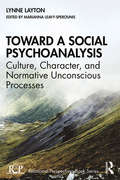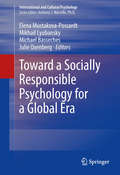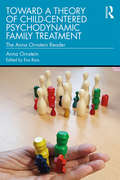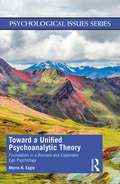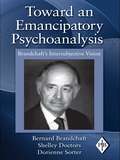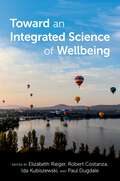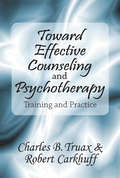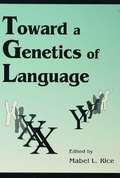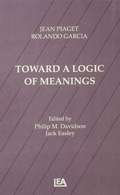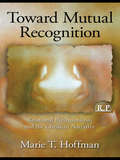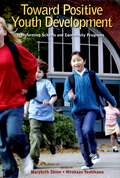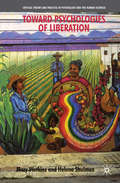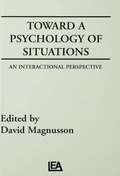- Table View
- List View
Toward a Social Psychoanalysis: Culture, Character, and Normative Unconscious Processes (Relational Perspectives Book Series)
by Lynne LaytonFrantz Fanon, Erich Fromm, Pierre Bourdieu, and Marie Langer are among those activists, clinicians, and academics who have called for a social psychoanalysis. For over thirty years, Lynne Layton has heeded this call and produced a body of work that examines unconscious process as it operates both in the social world and in the clinic. In this volume of Layton’s most important papers, she expands on earlier theorists’ ideas of social character by exploring how dominant ideologies and culturally mandated, hierarchical identity prescriptions are lived in individual and relational conflict. Through clinical and cultural examples, Layton describes how enactments of what she calls ‘normative unconscious processes’ reinforce cultural inequalities of race, sex, gender, and class both inside and outside the clinic, and at individual, interpersonal, and institutional levels. Clinicians, academics, and activists alike will find here a deeper understanding of the power of unconscious process, and are called on to envision and enact a progressive future in which vulnerability and interdependency are honored and systemic inequalities dismantled.
Toward a Socially Responsible Psychology for a Global Era (International and Cultural Psychology)
by Elena Mustakova-Possardt Mikhail Lyubansky Michael Basseches Julie OxenbergThis book explores the concept of “socially-responsible psychology in a global age” and how it might be used to organize, integrate and bring enhanced focus a field that has the potential to contribute to solutions to the world’s most pressing problems. In this volume, the editors explore the central and defining features of socially-responsible psychology, challenges that this work would face, and the mechanisms and processes by which psychological work could be synergistically integrated with the work of other disciplines. For this purpose, the volume also examines a variety of factors currently that limit psychology in carrying out this goal.
Toward a Theory of Child-Centered Psychodynamic Family Treatment: The Anna Ornstein Reader
by Anna OrnsteinToward a Theory of Child-Centered Psychodynamic Family Treatment: The Anna Ornstein Reader offers a clear introduction to Anna Ornstein’s ground-breaking work on psychoanalytic child orientated family therapy. Drawing on her writing from across her long career and including new material, the book sets out her important theoretical work on the mind, self, development, and parental influences, and the therapeutic consequences of these concepts. Anna Ornstein’s self-psychological work is unique and outstanding. First published in 1974, a time when attachment and affect regulation theory had just started, Ornstein’s work has developed far-reaching ideas, therapeutic concepts, and practicable approaches for psychodynamic children and adolescence therapy, based on the concept of analytic self-psychology, which has anticipated very early results of later affect regulation and attachment research. This kind of treatment considers parental work not as only accompanying, but as central, representing the core of the treatment process. The parental maturation process is directly described, which should enable the parents to accompany their child empathically, and therefore attachment-security enhancing. This treatment concept integrates the later findings of neurobiologically-based attachment and affect regulation theory which emphasizes that intrapsychic and interpersonal experience are in a continuous and everlasting exchange. In this book, Eva Rass offers a better understanding of Ornstein’s approach, an insight into her life and work, and an introduction into the concept of analytic self psychology, followed by a selection of Ornstein’s significant publications, in which the central concern is clearly elaborated, to give the reader a thorough introduction and understanding of her work. This book will be of great value and interest to professionals working with children and families in psychoanalytic settings, and to students training in child psychoanalysis, psychotherapy, and family therapy.
Toward a Theory of Child-Centered Psychodynamic Family Treatment: The Anna Ornstein Reader
by Anna OrnsteinToward a Theory of Child-Centered Psychodynamic Family Treatment: The Anna Ornstein Reader offers a clear introduction to Anna Ornstein’s ground-breaking work on psychoanalytic child orientated family therapy. Drawing on her writing from across her long career and including new material, the book sets out her important theoretical work on the mind, self, development, and parental influences, and the therapeutic consequences of these concepts. Anna Ornstein’s self-psychological work is unique and outstanding. First published in 1974, a time when attachment and affect regulation theory had just started, Ornstein’s work has developed far-reaching ideas, therapeutic concepts, and practicable approaches for psychodynamic children and adolescence therapy, based on the concept of analytic self-psychology, which has anticipated very early results of later affect regulation and attachment research. This kind of treatment considers parental work not as only accompanying, but as central, representing the core of the treatment process. The parental maturation process is directly described, which should enable the parents to accompany their child empathically, and therefore attachment-security enhancing. This treatment concept integrates the later findings of neurobiologically-based attachment and affect regulation theory which emphasizes that intrapsychic and interpersonal experience are in a continuous and everlasting exchange. In this book, Eva Rass offers a better understanding of Ornstein’s approach, an insight into her life and work, and an introduction into the concept of analytic self psychology, followed by a selection of Ornstein’s significant publications, in which the central concern is clearly elaborated, to give the reader a thorough introduction and understanding of her work. This book will be of great value and interest to professionals working with children and families in psychoanalytic settings, and to students training in child psychoanalysis, psychotherapy, and family therapy.
Toward a Unified Psychoanalytic Theory: Foundation in a Revised and Expanded Ego Psychology (Psychological Issues)
by Morris N EagleThis book aims to integrate different psychoanalytic schools and relevant research findings into an integrated psychoanalytic theory of the mind. A main claim explored here, is that a revised and expanded ego psychology constitutes the strongest foundation not only for a unified psychoanalytic theory, but also for the integration of relevant research findings from other disciplines. Sophisticated yet accessible, the book includes a description of the basic tenets of ego psychology and necessary correctives and revisions. It also discusses research and theory on interpersonal understanding, capacity for inhibition, defense, delay of gratification, autonomous ego aims and motives, affect regulation, the nature of psychopathology; and the implications of a revised and expanded ego psychology for approaches to treatment. The book will appeal to readers who are interested in psychoanalysis, the nature of the mind, the nature of psychopathology, and the implications of theoretical formulations and research findings for approaches to treatment. As such, it will also be of great value on graduate and training courses for psychoanalysis.
Toward a Unified Psychoanalytic Theory: Foundation in a Revised and Expanded Ego Psychology (Psychological Issues)
by Morris N EagleThis book aims to integrate different psychoanalytic schools and relevant research findings into an integrated psychoanalytic theory of the mind. A main claim explored here, is that a revised and expanded ego psychology constitutes the strongest foundation not only for a unified psychoanalytic theory, but also for the integration of relevant research findings from other disciplines. Sophisticated yet accessible, the book includes a description of the basic tenets of ego psychology and necessary correctives and revisions. It also discusses research and theory on interpersonal understanding, capacity for inhibition, defense, delay of gratification, autonomous ego aims and motives, affect regulation, the nature of psychopathology; and the implications of a revised and expanded ego psychology for approaches to treatment. The book will appeal to readers who are interested in psychoanalysis, the nature of the mind, the nature of psychopathology, and the implications of theoretical formulations and research findings for approaches to treatment. As such, it will also be of great value on graduate and training courses for psychoanalysis.
Toward an Emancipatory Psychoanalysis: Brandchaft's Intersubjective Vision (Psychoanalytic Inquiry Book Series)
by Bernard Brandchaft Shelley Doctors Dorienne SorterBest known for his contributions to the development of contemporary intersubjectivity theory, Bernard Brandchaft has dedicated a career to the advancement of psychoanalytic theory and practice. Continually searching for a theoretical viewpoint that would satisfactorily explain the clinical phenomena he was encountering, his curiosity eventually led him to the work of Heinz Kohut and the then-emerging school of self psychology. However, seemingly always one step ahead of the crowd, Brandchaft constantly reformulated his ideas about and investigations into the intersubjective nature of human experiences. Many of the chapters in this volume have never before been published. Together, they articulate the evolution of Brandchaft's thinking along the road toward an emancipatory psychoanalysis. Moreover, commentary from Shelley Doctors and Dorienne Sorter – in addition to Bernard Brandchaft himself – examines the clinical implications of the theoretical shifts that he advocated and provides a contemporary context for the case material and conclusions each paper presents. These theoretical shifts, both clear and subtle, are thereby elucidated to form the grand narrative of a truly visionary psychoanalytic thinker.
Toward an Emancipatory Psychoanalysis: Brandchaft's Intersubjective Vision (Psychoanalytic Inquiry Book Series)
by Bernard Brandchaft Shelley Doctors Dorienne SorterBest known for his contributions to the development of contemporary intersubjectivity theory, Bernard Brandchaft has dedicated a career to the advancement of psychoanalytic theory and practice. Continually searching for a theoretical viewpoint that would satisfactorily explain the clinical phenomena he was encountering, his curiosity eventually led him to the work of Heinz Kohut and the then-emerging school of self psychology. However, seemingly always one step ahead of the crowd, Brandchaft constantly reformulated his ideas about and investigations into the intersubjective nature of human experiences. Many of the chapters in this volume have never before been published. Together, they articulate the evolution of Brandchaft's thinking along the road toward an emancipatory psychoanalysis. Moreover, commentary from Shelley Doctors and Dorienne Sorter – in addition to Bernard Brandchaft himself – examines the clinical implications of the theoretical shifts that he advocated and provides a contemporary context for the case material and conclusions each paper presents. These theoretical shifts, both clear and subtle, are thereby elucidated to form the grand narrative of a truly visionary psychoanalytic thinker.
Toward an Integrated Science of Wellbeing
by Elizabeth Rieger, Robert Costanza, Ida Kubiszewski, Paul DugdaleThere has always been interest in understanding what constitutes the good life and the basis for creating it. Much has been written about health and wellbeing at multiple scales, from the physical and psychological through to the societal and environmental. Wellbeing has been studied from the perspectives of psychology, medicine, economics, social science, ecology, and political science. However, the interconnections between these scales and perspectives have received far less attention, even though understanding these interdependencies is critical to the comprehensive understanding of wellbeing and how to improve it. In Toward an Integrated Science of Wellbeing, the contributing authors connect these diverse scales and perspectives to better guide wellbeing research and public policy. The book is divided into four sections representing each domain of wellbeing research--psychological, human biological, societal, and environmental--but the authors extend their work to consider the interconnections between these domains, seeking integration across all scales throughout. Individual chapters explore topics such as indigenous perspectives and wellbeing, wellbeing in higher education, positive ageing, inequality and wellbeing, health and climate change, and greenspaces and wellbeing. This integrated approach offers a first step toward a more complete understanding of wellbeing that can propel wellbeing research and initiatives in novel and fruitful directions.
Toward an Integrated Science of Wellbeing
There has always been interest in understanding what constitutes the good life and the basis for creating it. Much has been written about health and wellbeing at multiple scales, from the physical and psychological through to the societal and environmental. Wellbeing has been studied from the perspectives of psychology, medicine, economics, social science, ecology, and political science. However, the interconnections between these scales and perspectives have received far less attention, even though understanding these interdependencies is critical to the comprehensive understanding of wellbeing and how to improve it. In Toward an Integrated Science of Wellbeing, the contributing authors connect these diverse scales and perspectives to better guide wellbeing research and public policy. The book is divided into four sections representing each domain of wellbeing research--psychological, human biological, societal, and environmental--but the authors extend their work to consider the interconnections between these domains, seeking integration across all scales throughout. Individual chapters explore topics such as indigenous perspectives and wellbeing, wellbeing in higher education, positive ageing, inequality and wellbeing, health and climate change, and greenspaces and wellbeing. This integrated approach offers a first step toward a more complete understanding of wellbeing that can propel wellbeing research and initiatives in novel and fruitful directions.
Toward Effective Counseling and Psychotherapy: Training and Practice
by Robert CarkhuffThe field of counseling and psychotherapy has for years presented the puzzling spectacle of unabating enthusiasm for forms of treatment whose effectiveness cannot be objectively demonstrated. With few exceptions, statistical studies have consistently failed to show that any form of psychotherapy is followed by significantly more improvement than would be caused by the mere passage of an equivalent period of time. Despite this, practitioners of various psychotherapeutic schools have remained firmly convinced that their methods are effective. Many recipients of these forms of treatment also believe that they are being helped.The series of investigations reported in this impressive book resolve this paradoxical state of affairs. The investigators have overcome two major obstacles to progress in the past--lack of agreement on measures of improvement and difficulty of measuring active ingredients of the psychotherapy relationship. The inability of therapists of different theoretical persuasions to agree on criteria of improvement has made comparison of the results of different forms of treatment nearly impossible. The authors have solved this intractable problem by using a wide range of improvement measures and showing that, regardless of measures used in different studies, a significantly higher proportion of results favor their hypothesis than disregard it.Overall, this book represented a major advance at the time of its original publication and is of continuing importance. The research findings resolve some of the most stubborn research problems in psychotherapy, and the training program based on them points the way toward overcoming the shortage of psychotherapists.
Toward Effective Counseling and Psychotherapy: Training and Practice
by Robert CarkhuffThe field of counseling and psychotherapy has for years presented the puzzling spectacle of unabating enthusiasm for forms of treatment whose effectiveness cannot be objectively demonstrated. With few exceptions, statistical studies have consistently failed to show that any form of psychotherapy is followed by significantly more improvement than would be caused by the mere passage of an equivalent period of time. Despite this, practitioners of various psychotherapeutic schools have remained firmly convinced that their methods are effective. Many recipients of these forms of treatment also believe that they are being helped.The series of investigations reported in this impressive book resolve this paradoxical state of affairs. The investigators have overcome two major obstacles to progress in the past--lack of agreement on measures of improvement and difficulty of measuring active ingredients of the psychotherapy relationship. The inability of therapists of different theoretical persuasions to agree on criteria of improvement has made comparison of the results of different forms of treatment nearly impossible. The authors have solved this intractable problem by using a wide range of improvement measures and showing that, regardless of measures used in different studies, a significantly higher proportion of results favor their hypothesis than disregard it.Overall, this book represented a major advance at the time of its original publication and is of continuing importance. The research findings resolve some of the most stubborn research problems in psychotherapy, and the training program based on them points the way toward overcoming the shortage of psychotherapists.
Toward A Genetics of Language
by Mabel L. RiceThe past decade has brought important new advances in the fields of genetics, behavioral genetics, linguistics, language acquisition, studies of language impairment, and brain imaging. Although these advances are each highly relevant to the determination of what a child is innately prepared to bring to language acquisition, the contributing fields of endeavor have traditionally been relatively self-contained, with little cross communication. This volume was developed with the belief that there is considerable value to be gained in the creation of a shared platform for a dialogue across the disciplines.Leading experts in genetics, linguistics, language acquisition, language impairment, and brain imaging are brought together for the purpose of exploring the current evidence, theoretical issues, and research challenges in a way that bridges disciplinary boundaries and points toward future developments in the search for the genetic and environmental bases of language acquisition and impairments. This collection provides discussions and summaries of: *breakthrough findings of the genetic underpinnings of dyslexia; *theoretical and empirical developments in the specification of a phenotype of language acquisition and impairment; *evidence of familiarity and twin concordances of specific language impairment; and*new evidence from brain imaging.It concludes with a critical response from an advocate of rational empiricism.
Toward A Genetics of Language
by Mabel L. RiceThe past decade has brought important new advances in the fields of genetics, behavioral genetics, linguistics, language acquisition, studies of language impairment, and brain imaging. Although these advances are each highly relevant to the determination of what a child is innately prepared to bring to language acquisition, the contributing fields of endeavor have traditionally been relatively self-contained, with little cross communication. This volume was developed with the belief that there is considerable value to be gained in the creation of a shared platform for a dialogue across the disciplines.Leading experts in genetics, linguistics, language acquisition, language impairment, and brain imaging are brought together for the purpose of exploring the current evidence, theoretical issues, and research challenges in a way that bridges disciplinary boundaries and points toward future developments in the search for the genetic and environmental bases of language acquisition and impairments. This collection provides discussions and summaries of: *breakthrough findings of the genetic underpinnings of dyslexia; *theoretical and empirical developments in the specification of a phenotype of language acquisition and impairment; *evidence of familiarity and twin concordances of specific language impairment; and*new evidence from brain imaging.It concludes with a critical response from an advocate of rational empiricism.
Toward Human-Level Artificial Intelligence: How Neuroscience Can Inform the Pursuit of Artificial General Intelligence or General AI
by Eitan Michael AzoffIs a computer simulation of a brain sufficient to make it intelligent? Do you need consciousness to have intelligence? Do you need to be alive to have consciousness? This book has a dual purpose. First, it provides a multi-disciplinary research survey across all branches of neuroscience and AI research that relate to this book’s mission of bringing AI research closer to building a human-level AI (HLAI) system. It provides an encapsulation of key ideas and concepts, and provides all the references for the reader to delve deeper; much of the survey coverage is of recent pioneering research. Second, the final part of this book brings together key concepts from the survey and makes suggestions for building HLAI. This book provides accessible explanations of numerous key concepts from neuroscience and artificial intelligence research, including: The focus on visual processing and thinking and the possible role of brain lateralization toward visual thinking and intelligence. Diffuse decision making by ensembles of neurons. The inside-out model to give HLAI an inner "life" and the possible role for cognitive architecture implementing the scientific method through the plan-do-check-act cycle within that model (learning to learn). A neuromodulation feature such as a machine equivalent of dopamine that reinforces learning. The embodied HLAI machine, a neurorobot, that interacts with the physical world as it learns. This book concludes by explaining the hypothesis that computer simulation is sufficient to take AI research further toward HLAI and that the scientific method is our means to enable that progress. This book will be of great interest to a broad audience, particularly neuroscientists and AI researchers, investors in AI projects, and lay readers looking for an accessible introduction to the intersection of neuroscience and artificial intelligence.
Toward Human-Level Artificial Intelligence: How Neuroscience Can Inform the Pursuit of Artificial General Intelligence or General AI
by Eitan Michael AzoffIs a computer simulation of a brain sufficient to make it intelligent? Do you need consciousness to have intelligence? Do you need to be alive to have consciousness? This book has a dual purpose. First, it provides a multi-disciplinary research survey across all branches of neuroscience and AI research that relate to this book’s mission of bringing AI research closer to building a human-level AI (HLAI) system. It provides an encapsulation of key ideas and concepts, and provides all the references for the reader to delve deeper; much of the survey coverage is of recent pioneering research. Second, the final part of this book brings together key concepts from the survey and makes suggestions for building HLAI. This book provides accessible explanations of numerous key concepts from neuroscience and artificial intelligence research, including: The focus on visual processing and thinking and the possible role of brain lateralization toward visual thinking and intelligence. Diffuse decision making by ensembles of neurons. The inside-out model to give HLAI an inner "life" and the possible role for cognitive architecture implementing the scientific method through the plan-do-check-act cycle within that model (learning to learn). A neuromodulation feature such as a machine equivalent of dopamine that reinforces learning. The embodied HLAI machine, a neurorobot, that interacts with the physical world as it learns. This book concludes by explaining the hypothesis that computer simulation is sufficient to take AI research further toward HLAI and that the scientific method is our means to enable that progress. This book will be of great interest to a broad audience, particularly neuroscientists and AI researchers, investors in AI projects, and lay readers looking for an accessible introduction to the intersection of neuroscience and artificial intelligence.
Toward A Logic of Meanings
by Jean Piaget Rolando Garcia Philip DavidsonThis book, the last one written by Piaget, presents a new line of empirical studies based on a revised formulation of his theory of the development of logical reasoning. The amended theory overcomes many problems and criticisms of his earlier formulations by providing a fresh explanation for the origin of mental operations and mental organization based on the concept of meaning. It also offers a more elegant vision of the continuity in mental development from birth to adulthood. As the final revision of Piaget's theory -- and one that opens up new areas of inquiry -- this book calls for a reinterpretation of his earlier work -- a task which will occupy scholars for decades to come.
Toward A Logic of Meanings
by Jean Piaget Rolando Garcia Philip DavidsonThis book, the last one written by Piaget, presents a new line of empirical studies based on a revised formulation of his theory of the development of logical reasoning. The amended theory overcomes many problems and criticisms of his earlier formulations by providing a fresh explanation for the origin of mental operations and mental organization based on the concept of meaning. It also offers a more elegant vision of the continuity in mental development from birth to adulthood. As the final revision of Piaget's theory -- and one that opens up new areas of inquiry -- this book calls for a reinterpretation of his earlier work -- a task which will occupy scholars for decades to come.
Toward Mutual Recognition: Relational Psychoanalysis and the Christian Narrative (Relational Perspectives Book Series)
by Marie T. HoffmanEver since its nascent days, psychoanalysis has enjoyed an uneasy coexistence with religion. However, in recent decades, many analysts have been more interested in the healing potential of both psychoanalytic and religious experience and have explored how their respective narrative underpinnings may be remarkably similar. In Toward Mutual Recognition, Marie T. Hoffman takes just such an approach. Coming from a Christian perspective, she suggests that the current relational turn in psychoanalysis has been influenced by numerous theorists - analysts and philosophers alike - who were themselves shaped by an embedded Christian narrative. As a result, the redemptive concepts of incarnation, crucifixion, and resurrection - central to the tenets of Christianity - can be traced to relational theories, emerging analogously in the transformative process of mutual recognition in the concepts of identification, surrender, and gratitude, a trilogy which she develops as forming the "path of recognition." Each movement on this path of recognition is given thought-provoking, in-depth attention. Chapters dedicated to theoretical perspectives utilize the thinking of Benjamin, Hegel, and Ricoeur. In her historical perspectives, she explores the personal and professional histories of analysts such as Sullivan, Fairbairn, Winnicott, Erikson, Kohut, and Ferenczi, among others, who were influenced by the Christian narrative. Uniting it all together is the clinical perspective offered in the compelling extended case history of Mandy, a young lady whose treatment embodies and exemplifies each of the steps along the path of growth in both the psychoanalytic and Christian senses. Throughout, a relational sensibility is deployed as a cooperative counterpart to the Christian narrative, working both as a consilient dialogue and a vehicle for further integrative exploration. As a result, the specter of psychoanalysis and religion as mutually exclusive gives way to the hope and redemption offered by their mutual recognition.
Toward Mutual Recognition: Relational Psychoanalysis and the Christian Narrative (Relational Perspectives Book Series)
by Marie T. HoffmanEver since its nascent days, psychoanalysis has enjoyed an uneasy coexistence with religion. However, in recent decades, many analysts have been more interested in the healing potential of both psychoanalytic and religious experience and have explored how their respective narrative underpinnings may be remarkably similar. In Toward Mutual Recognition, Marie T. Hoffman takes just such an approach. Coming from a Christian perspective, she suggests that the current relational turn in psychoanalysis has been influenced by numerous theorists - analysts and philosophers alike - who were themselves shaped by an embedded Christian narrative. As a result, the redemptive concepts of incarnation, crucifixion, and resurrection - central to the tenets of Christianity - can be traced to relational theories, emerging analogously in the transformative process of mutual recognition in the concepts of identification, surrender, and gratitude, a trilogy which she develops as forming the "path of recognition." Each movement on this path of recognition is given thought-provoking, in-depth attention. Chapters dedicated to theoretical perspectives utilize the thinking of Benjamin, Hegel, and Ricoeur. In her historical perspectives, she explores the personal and professional histories of analysts such as Sullivan, Fairbairn, Winnicott, Erikson, Kohut, and Ferenczi, among others, who were influenced by the Christian narrative. Uniting it all together is the clinical perspective offered in the compelling extended case history of Mandy, a young lady whose treatment embodies and exemplifies each of the steps along the path of growth in both the psychoanalytic and Christian senses. Throughout, a relational sensibility is deployed as a cooperative counterpart to the Christian narrative, working both as a consilient dialogue and a vehicle for further integrative exploration. As a result, the specter of psychoanalysis and religion as mutually exclusive gives way to the hope and redemption offered by their mutual recognition.
Toward Positive Youth Development: Transforming Schools and Community Programs
by Marybeth ShinnSocial settings have enormous power to promote or hinder positive youth development. Researchers and practitioners know a great deal about features of schools and programs for youth that affect development, but much less about how to transform settings to bring about these desirable features. This book shows how to harness the power of settings. It shifts the debate from simply enhancing youth outcomes at the individual level to improving the settings of youths' daily lives. The book offers researchers and practitioners blueprints for creating and changing influential settings including classrooms, schools, universities, out-of-school time programs, ethnic systems of supplementary education, and other community-based programs. Leading scholars in psychology, education, human development, sociology, anthropology, economics, law, and public policy discuss a wide array of social change strategies, and describe how to measure key features of settings as a target and guide for change. The authors also demonstrate how larger social structures - such as school districts, community coalitions, community data resources - can support change. Many of the chapters describe ways to make settings work for all youth, including those marginalized by reason of race, ethnicity, social class, or sexual orientation. Toward Positive Youth Development will guide researchers, educators, administrators and policy makers to improve schools and youth programs for all of America's youth.
Toward Positive Youth Development: Transforming Schools and Community Programs
by Marybeth Shinn Hirokazu YoshikawaSocial settings have enormous power to promote or hinder positive youth development. Researchers and practitioners know a great deal about features of schools and programs for youth that affect development, but much less about how to transform settings to bring about these desirable features. This book shows how to harness the power of settings. It shifts the debate from simply enhancing youth outcomes at the individual level to improving the settings of youths' daily lives. The book offers researchers and practitioners blueprints for creating and changing influential settings including classrooms, schools, universities, out-of-school time programs, ethnic systems of supplementary education, and other community-based programs. Leading scholars in psychology, education, human development, sociology, anthropology, economics, law, and public policy discuss a wide array of social change strategies, and describe how to measure key features of settings as a target and guide for change. The authors also demonstrate how larger social structures - such as school districts, community coalitions, community data resources - can support change. Many of the chapters describe ways to make settings work for all youth, including those marginalized by reason of race, ethnicity, social class, or sexual orientation. Toward Positive Youth Development will guide researchers, educators, administrators and policy makers to improve schools and youth programs for all of America's youth.
Toward Psychologies of Liberation (Critical Theory and Practice in Psychology and the Human Sciences)
by M. Watkins H. ShulmanPsychologies of liberation are emerging on every continent in response to the collective traumas inflicted by colonialism and globalization. The authors present the theoretical foundation and participatory methodologies that unite these radical interdisciplinary approaches to creating individual and community well-being. They move from a description of the psychological and community wounds that are common to unjust and violent contexts to engaging examples of innovative community projects from around the world that seek to heal these wounds. The creation of public homeplaces, and the work of liberation arts, critical participatory action research, public dialogue, and reconciliation are highlighted as embodying the values and hopes of liberation psychology. Drawing on psychoanalysis, trauma studies, liberation arts, participatory research, and contemporary cultural work, this book nourishes our understanding of and imagination about the kinds of healing that are necessary to the creation of more just and peaceful communities. In dialogue with cultural workers, writers, and visionaries from Latin America, Africa, Asia, Europe, the United States, and the Pacific Islands, Toward Psychologies of Liberation quickens a dialogical convergence of liberatory psychological theories and practices that will seed individual and community transformation.
Toward A Psychology of Situations: An Interactional Perspective
by David MagnussonPublished in the year 1981, Toward a Psychology of Situations is a valuable contribution to the field of Social Psychology.
Toward A Psychology of Situations: An Interactional Perspective
by David Magnusson D. MagnussonPublished in the year 1981, Toward a Psychology of Situations is a valuable contribution to the field of Social Psychology.
